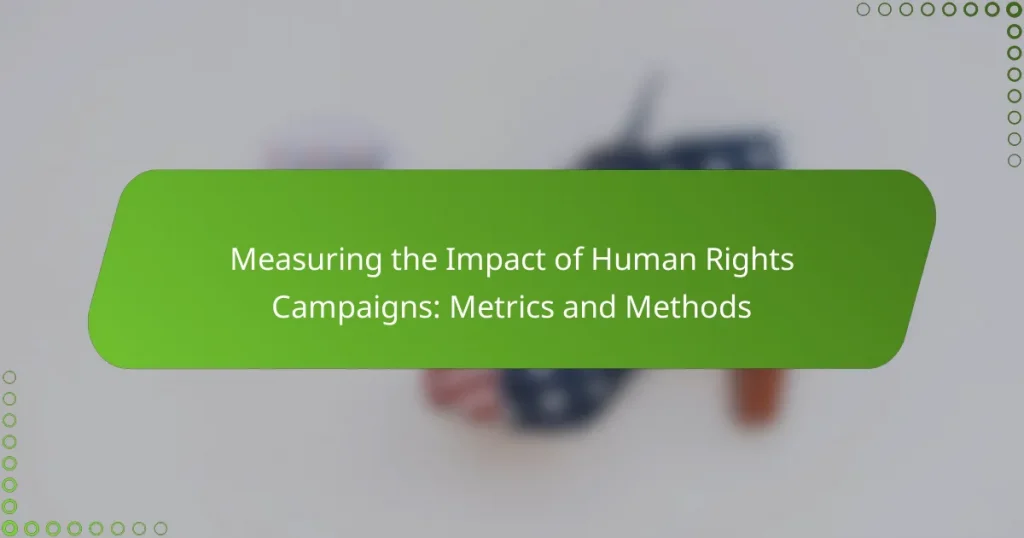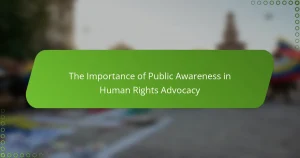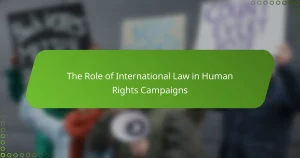Measuring the impact of human rights campaigns is essential for promoting and protecting individual rights against discrimination, violence, and inequality. This article explores the challenges associated with quantifying the effectiveness of these campaigns, including the difficulty of measuring qualitative outcomes and the lack of standardized metrics. It highlights the importance of both quantitative and qualitative assessments, such as policy changes and personal testimonies, in evaluating success. Best practices for enhancing measurement accuracy are also discussed, emphasizing the establishment of clear objectives, stakeholder engagement, and regular metric reviews. Understanding these elements is crucial for improving advocacy and ensuring accountability in human rights initiatives.
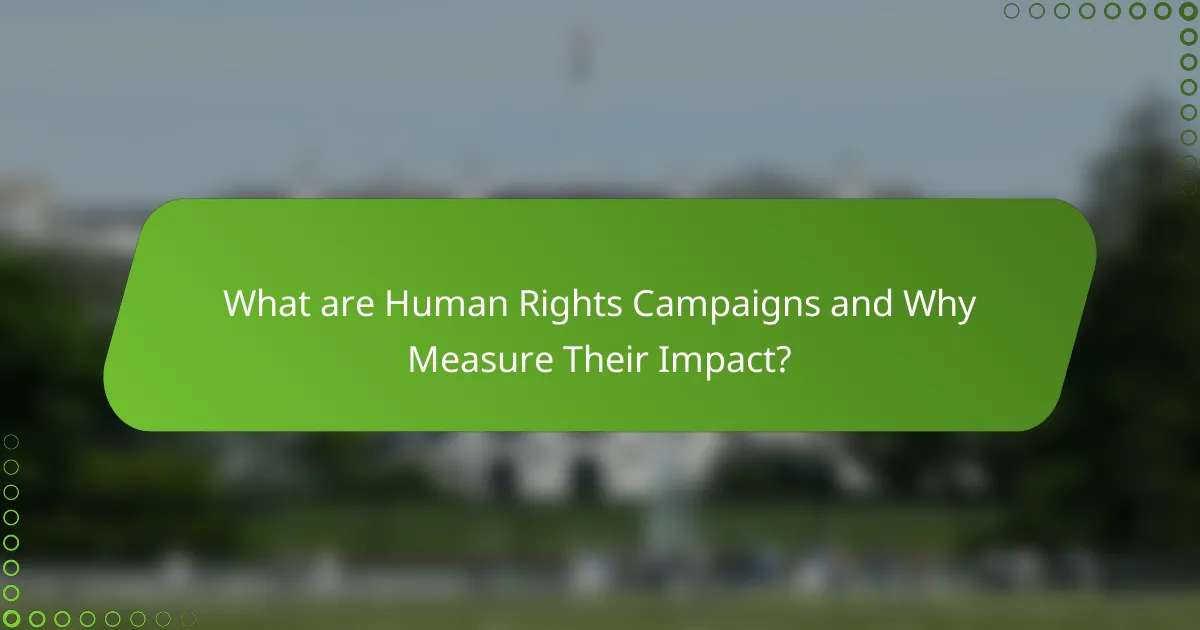
What are Human Rights Campaigns and Why Measure Their Impact?
Human rights campaigns are organized efforts aimed at promoting and protecting the fundamental rights of individuals. These campaigns address issues such as discrimination, violence, and inequality. Measuring their impact is essential to evaluate effectiveness and inform future strategies. Quantitative metrics, such as changes in policy or public awareness, provide concrete evidence of success. Qualitative assessments, like personal testimonies, illustrate the campaigns’ human impact. Research indicates that effective measurement can lead to improved advocacy and resource allocation. According to the UN, tracking progress in human rights is crucial for accountability and sustained change.
How do Human Rights Campaigns function in society?
Human rights campaigns function in society by advocating for the protection and promotion of individual rights. These campaigns raise awareness about human rights violations. They mobilize public opinion to influence policy changes. Campaigns often utilize social media to reach a broader audience. They organize events and demonstrations to garner support. Research shows that human rights campaigns can lead to legislative reforms. For example, the United Nations Universal Declaration of Human Rights was influenced by various advocacy efforts. These campaigns also provide support to victims of human rights abuses, helping them seek justice. Overall, they play a crucial role in shaping societal norms and values regarding human dignity.
What are the primary goals of Human Rights Campaigns?
The primary goals of Human Rights Campaigns are to promote equality and protect the rights of marginalized groups. These campaigns aim to raise awareness about human rights violations. They advocate for legislative changes to ensure equal treatment under the law. Human Rights Campaigns also seek to educate the public on human rights issues. They work to mobilize communities for collective action. Additionally, these campaigns often provide support and resources to victims of discrimination. By fostering dialogue, they aim to create social change. Statistics show that effective campaigns can lead to significant policy reforms and increased public support for human rights.
Who are the key stakeholders involved in Human Rights Campaigns?
Key stakeholders involved in human rights campaigns include non-governmental organizations (NGOs), government agencies, and international bodies. NGOs play a crucial role in advocating for human rights and mobilizing public support. Government agencies are responsible for implementing policies and laws that protect human rights. International bodies, such as the United Nations, monitor human rights conditions globally and promote compliance among nations. Additionally, local communities and activists are essential for grassroots mobilization and raising awareness. Funders and donors also support these campaigns financially, enabling their activities and outreach efforts.
What metrics are used to measure the impact of Human Rights Campaigns?
Metrics used to measure the impact of Human Rights Campaigns include awareness levels, policy changes, and community engagement. Awareness levels can be assessed through surveys and social media analytics. Policy changes are tracked by monitoring legislation and government actions influenced by campaigns. Community engagement is evaluated by participation rates in events and volunteer activities. Additionally, media coverage and public sentiment analysis provide insights into the campaigns’ reach and effectiveness. These metrics collectively offer a comprehensive view of the campaigns’ impacts on society and policy.
What qualitative metrics can be applied to assess impact?
Qualitative metrics to assess impact include participant feedback, case studies, and narrative analysis. Participant feedback gathers personal experiences and perceptions regarding the campaign. Case studies provide in-depth examinations of specific instances where the campaign influenced change. Narrative analysis evaluates stories shared by individuals affected by the campaign. These metrics help capture the nuanced effects of human rights initiatives. They offer insights into emotional and social transformations that quantitative data may overlook. Implementing these metrics allows for a comprehensive understanding of the campaign’s effectiveness.
What quantitative metrics are commonly utilized in evaluations?
Common quantitative metrics utilized in evaluations include surveys, focus groups, and demographic data. Surveys can measure participant attitudes and awareness levels. Focus groups provide qualitative insights that can be quantified. Demographic data helps in understanding the reach and impact of campaigns. Other metrics include participation rates, funding amounts, and social media engagement statistics. These metrics allow for a comprehensive assessment of campaign effectiveness. Research supports the use of these metrics in evaluating human rights initiatives. Studies show that quantifiable data enhances the understanding of campaign outcomes and areas for improvement.
How do different methods influence the measurement of Human Rights Campaigns?
Different methods significantly influence the measurement of Human Rights Campaigns. Quantitative methods provide statistical data that can highlight trends and impacts over time. Surveys and polls can quantify public opinion regarding human rights issues. Qualitative methods, such as interviews and focus groups, offer in-depth insights into personal experiences. These methods capture the nuances of human rights violations that numbers alone may overlook. Mixed methods combine both approaches, offering a more comprehensive understanding of campaign effectiveness. For example, a study by the International Human Rights Clinic found that mixed methods improved the evaluation of human rights advocacy efforts by providing both statistical evidence and personal narratives. Therefore, the choice of method directly affects the quality and depth of the measurement outcomes.
What are the most common methodologies for impact assessment?
The most common methodologies for impact assessment include qualitative and quantitative approaches. Qualitative methods involve interviews, focus groups, and case studies to gather in-depth insights. Quantitative methods utilize surveys, statistical analysis, and metrics to measure changes and outcomes. Mixed-methods approaches combine both qualitative and quantitative techniques for a comprehensive evaluation. The Theory of Change framework is also frequently used to outline expected outcomes and pathways. Additionally, cost-benefit analysis assesses the economic impact of interventions. These methodologies are widely recognized in various fields, including social sciences and public policy, to evaluate the effectiveness of programs and initiatives.
How do qualitative and quantitative methods differ in their approach?
Qualitative and quantitative methods differ fundamentally in their approach to data collection and analysis. Qualitative methods focus on understanding human experiences and social phenomena through in-depth interviews, focus groups, and observations. These methods aim to capture subjective perspectives and provide rich, detailed insights. In contrast, quantitative methods emphasize numerical data and statistical analysis. They utilize structured surveys and experiments to measure variables and identify patterns.
Quantitative approaches allow for generalization across larger populations due to their reliance on statistical validity. Qualitative methods, however, provide context and depth that numbers alone cannot convey. The two methods can complement each other, enriching the overall understanding of a research topic.
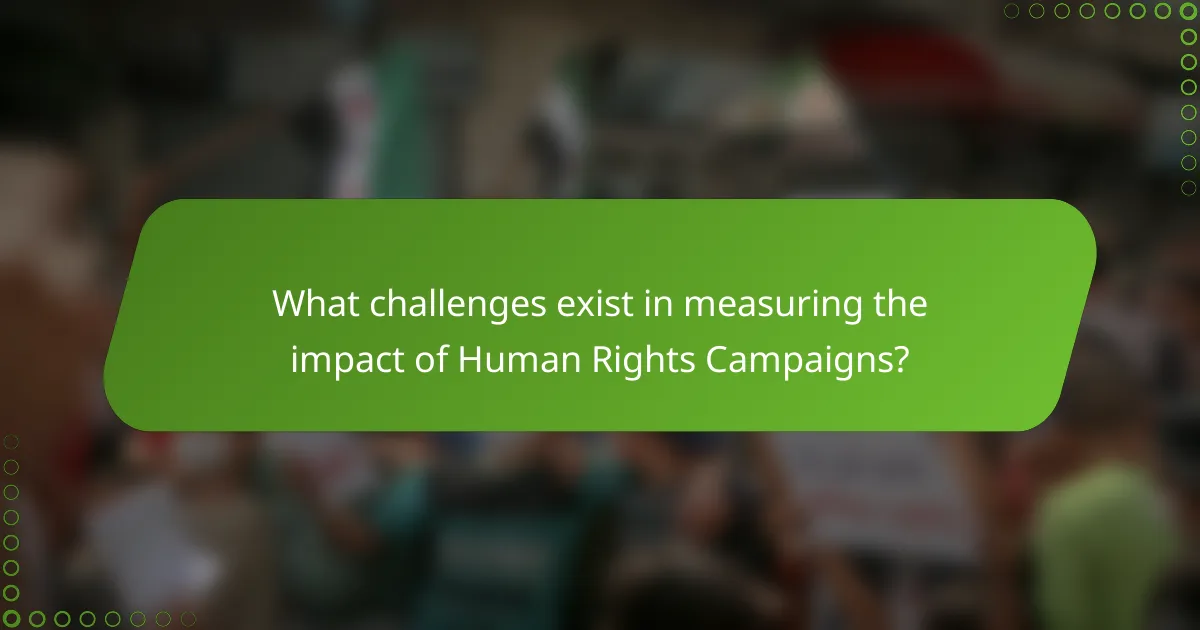
What challenges exist in measuring the impact of Human Rights Campaigns?
Measuring the impact of Human Rights Campaigns presents several challenges. One major challenge is the difficulty in quantifying qualitative outcomes. Human rights improvements often manifest in intangible ways, such as changes in societal attitudes. Another challenge is the lack of standardized metrics across different campaigns. Each campaign may prioritize different goals, making comparison difficult. Additionally, external factors can influence outcomes, complicating causal relationships. For instance, political changes or economic conditions may affect human rights progress independently of campaign efforts. Lastly, data collection can be hindered by access issues, particularly in oppressive regimes. These challenges collectively create a complex environment for assessing the true impact of human rights initiatives.
Why is it difficult to quantify the success of Human Rights Campaigns?
Quantifying the success of Human Rights Campaigns is difficult due to the complexity of measuring social change. Success often involves subjective interpretations of human rights improvements. Different stakeholders may have varying definitions of success. Additionally, the impact of campaigns can take years to manifest, making immediate measurement challenging. Data collection methods may lack consistency across different regions and contexts. The influence of external factors, such as political climates, complicates attribution of success to specific campaigns. Furthermore, qualitative changes, like shifts in public perception, are hard to quantify. These factors create a multifaceted landscape that complicates straightforward evaluation.
What factors contribute to the variability in impact measurement?
Variability in impact measurement is influenced by several factors. These include the context of the campaign, the methodologies used, and the specific metrics chosen. Contextual factors encompass cultural, political, and social environments that can affect outcomes. Methodological factors involve the design of the measurement approach, such as qualitative versus quantitative methods. The choice of metrics can also lead to variability, as different indicators may capture different aspects of impact. Additionally, stakeholder perspectives and biases can shape how impact is perceived and reported. Research shows that these factors can lead to inconsistent results across similar campaigns. For instance, a study by the International Human Rights Funders Group highlights the diverse methodologies used in assessing human rights impacts, leading to varied conclusions.
How do cultural differences affect the interpretation of metrics?
Cultural differences significantly affect the interpretation of metrics. Different cultures prioritize various values and beliefs, which influences how they view data. For example, individualistic cultures may focus on personal achievement metrics, while collectivist cultures may emphasize community outcomes. Additionally, cultural context shapes the significance attributed to certain metrics. In some cultures, numerical data may be seen as absolute, while others may view it as subjective. This variability can lead to misunderstandings or misapplications of metrics in diverse cultural settings. Research shows that culturally informed interpretations can enhance the relevance and effectiveness of metrics in human rights campaigns.
What are the limitations of current measurement methods?
Current measurement methods for assessing human rights campaigns face several limitations. These methods often lack standardization, leading to inconsistent results across different studies. Data collection can be biased, influenced by the subjective interpretations of respondents. Additionally, many metrics do not capture the long-term impact of campaigns effectively. Existing tools may overlook qualitative aspects, focusing primarily on quantitative data. Resource constraints can hinder comprehensive data gathering, especially in underfunded regions. Furthermore, cultural differences may affect the applicability of certain measurement tools. Finally, the dynamic nature of human rights issues may render some methods outdated quickly.
What biases can affect the data collected during assessments?
Biases that can affect data collected during assessments include selection bias, response bias, and confirmation bias. Selection bias occurs when the sample is not representative of the population. This can lead to skewed results that do not accurately reflect the broader context. Response bias happens when participants provide inaccurate answers due to social desirability or misunderstanding questions. This can distort the true opinions or behaviors being measured. Confirmation bias occurs when assessors favor information that confirms their pre-existing beliefs. This can lead to misinterpretation of data and flawed conclusions. Each of these biases can significantly impact the validity and reliability of assessment outcomes.
How can the limitations of measurement tools be mitigated?
Limitations of measurement tools can be mitigated by employing multiple methods of data collection. Triangulation increases reliability by comparing results from different sources. Regular calibration of tools ensures accuracy over time. Training personnel on proper usage enhances data quality. Utilizing technology can streamline data gathering and analysis. Feedback loops allow for continuous improvement of measurement processes. Pilot testing tools before full implementation identifies potential issues early. Engaging stakeholders can provide diverse perspectives, improving measurement relevance.
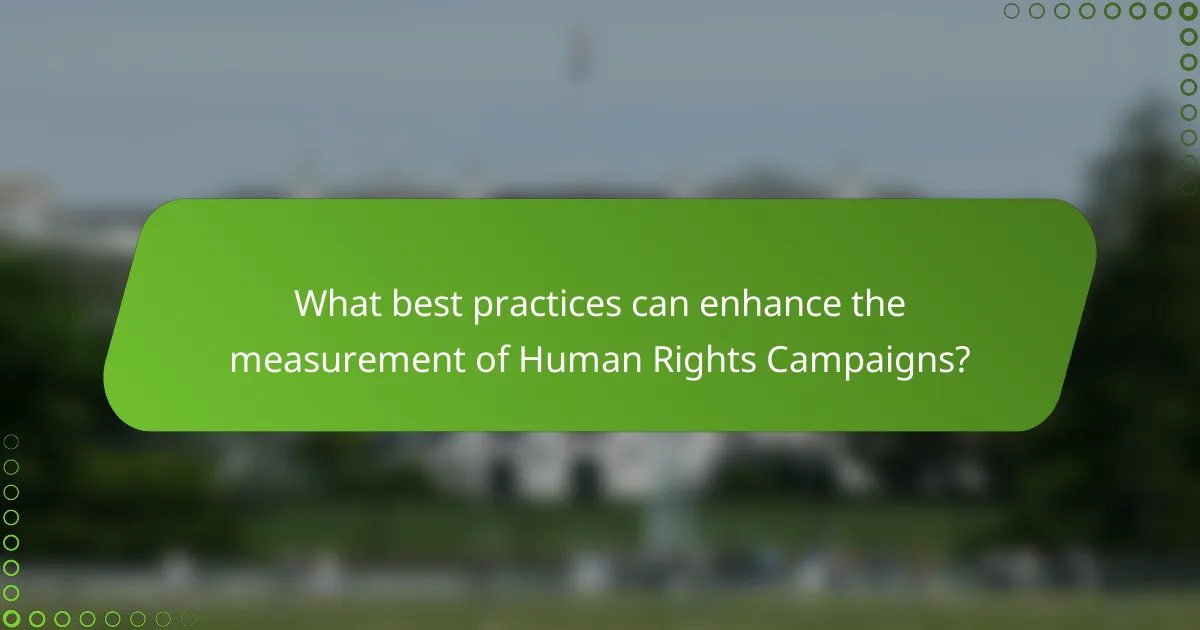
What best practices can enhance the measurement of Human Rights Campaigns?
Best practices to enhance the measurement of Human Rights Campaigns include establishing clear objectives and indicators. Defining specific goals allows for targeted evaluation. Utilizing both quantitative and qualitative data strengthens the analysis. Surveys and interviews can provide personal insights alongside numerical data. Engaging stakeholders in the measurement process fosters transparency and accountability. Regularly reviewing and adjusting metrics ensures relevance and effectiveness. Benchmarking against similar campaigns can offer comparative insights. These practices collectively improve the accuracy and impact of measurement efforts.
How can organizations improve their impact assessment strategies?
Organizations can improve their impact assessment strategies by implementing a systematic approach to data collection and analysis. This involves defining clear objectives and metrics aligned with their mission. Regularly reviewing and updating these metrics ensures they remain relevant. Engaging stakeholders in the assessment process enhances the quality of insights. Utilizing mixed-methods approaches, combining qualitative and quantitative data, provides a comprehensive view of impact. Training staff on data analysis techniques can increase their capacity to interpret findings effectively. A study by the Stanford Social Innovation Review highlights that organizations with robust assessment frameworks can better adapt their strategies based on evidence.
What role does stakeholder engagement play in effective measurement?
Stakeholder engagement is crucial for effective measurement in human rights campaigns. It ensures that the metrics used reflect the perspectives and needs of all relevant parties. Engaging stakeholders facilitates the identification of key performance indicators that matter most to them. This collaboration can lead to more accurate data collection and interpretation. When stakeholders are involved, they are more likely to support and validate the measurement processes. Research indicates that campaigns with strong stakeholder involvement report higher satisfaction and impact. Therefore, effective measurement is enhanced through inclusive stakeholder engagement practices.
How can technology be leveraged to enhance data collection?
Technology can enhance data collection through automation, real-time analytics, and improved data storage solutions. Automation reduces manual data entry errors and speeds up the collection process. Real-time analytics enable immediate insights from collected data, allowing for timely decision-making. Improved data storage solutions, such as cloud computing, ensure data is easily accessible and secure. According to a study by McKinsey, organizations using advanced analytics can improve their decision-making processes by 5 to 6 percent. Additionally, mobile applications facilitate on-the-ground data collection, increasing the volume and accuracy of information gathered in human rights campaigns.
What practical steps can be taken to measure impact effectively?
To measure impact effectively, establish clear objectives and metrics. Define what success looks like for the campaign. Use quantitative methods such as surveys or data analytics to gather measurable evidence. Qualitative methods like interviews can provide deeper insights into the impact. Regularly analyze data to assess progress against objectives. Adjust strategies based on findings to enhance effectiveness. Collaborate with stakeholders to ensure diverse perspectives are included. Document all findings to build a comprehensive understanding of the campaign’s impact.
What frameworks can guide organizations in their assessment processes?
Organizations can utilize several frameworks to guide their assessment processes. Common frameworks include the Logic Model, which outlines inputs, activities, outputs, outcomes, and impacts. Another framework is the Theory of Change, which helps organizations articulate how and why a desired change is expected to happen. The Balanced Scorecard is also popular; it provides a strategic planning and management system that aligns business activities to the vision and strategy of the organization. Additionally, the Results-Based Management framework focuses on achieving results through a systematic approach to planning, monitoring, and evaluation. Each of these frameworks offers structured methodologies that can enhance the effectiveness of assessments in human rights campaigns.
How can lessons learned from past campaigns inform future efforts?
Lessons learned from past campaigns can significantly inform future efforts by providing actionable insights. Analyzing previous campaigns reveals successful strategies and common pitfalls. For instance, campaigns that effectively engaged their target audience often saw higher participation rates. Data from the 2018 Women’s March indicated that grassroots mobilization led to increased visibility and impact. Furthermore, understanding the metrics used in past campaigns helps refine measurement techniques for future initiatives. Historical data can guide resource allocation and improve campaign messaging. Evaluating past audience feedback also allows for better alignment with community needs. Overall, leveraging these lessons enhances the effectiveness of future human rights campaigns.
The main entity of the article is “Human Rights Campaigns.” The article provides a comprehensive overview of how to measure the impact of these campaigns, emphasizing the importance of both quantitative and qualitative metrics. It discusses various methodologies for assessment, including the use of surveys, case studies, and stakeholder engagement. Key challenges in measuring success, such as cultural differences and biases, are also addressed. Finally, best practices and frameworks for effective impact assessment are outlined to enhance future human rights initiatives.
